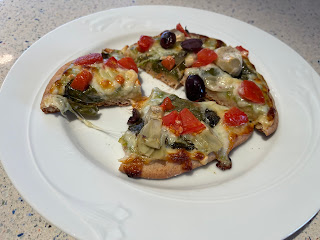I've been watching a lot of historical food channels lately, and it's pretty impressive how many ingredients we take for granted are native to the Americas. The most famous export to the rest of the world is probably the tomato. I didn't realize that most beans are American. Nearly all edible nightshades and about half of the gourds were unkown to ancient civilaztions on other continents. Then there's corn and quinoa. Corn may not be as pervasive across the other continents, but it probably makes up a significant portion of Americans by weight.
That said, my tomatoes finally ripened after I stopped planning recipes with tomatoes in them, so I chopped up a couple to put on these pizzas with everything else. The artichokes were a box I bought on clearance in case my home-grown wasn't enough for a full year. They were, so I defrosted half of them and sliced them up.
I forgot to buy a red onion, then realized that my pesto is onion-based and went out to pick basil instead. It needed a trim anyway. If you're using a traditional basil pesto, slice up a red onion to give this a little flavor contrast.
For the crust you can use store-bought, naan, a pizza crust dough - which I do not appear to have as a stand-alone; I'll fix that next time I make pizza - or an overnight pizza crust recipe. I made whole wheat naan.
1 large or 4 personal-sized pizza crusts
cornmeal to dust the pan
*1/2 C pesto
2 C mozzarella cheese
*2 cloves garlic, minced
1/2 red onion, sliced
*4 oz frozen artichoke hearts, quartered
*2 Roma or Campari tomatoes, diced
*8-12 Kalamata olives, halved
*handful of basil leaves, optional
4. Bake the pizzas according to the dough recipe. None of the toppings have to be cooked to a specific temperature. It will probably be around 20 minutes.
5. Once done, allow pizzas to rest 5-10 minutes before cutting and serving. I know, it's hard, but the dough and cheese really should finish their cooking process before you eat any. I burned the roof of my mouth a little.Difficulty rating π for store-bought crust, :) for homemade





No comments:
Post a Comment
I got tired of having to moderate all the spam comments and put back the verification. Sorry if it causes hassles.